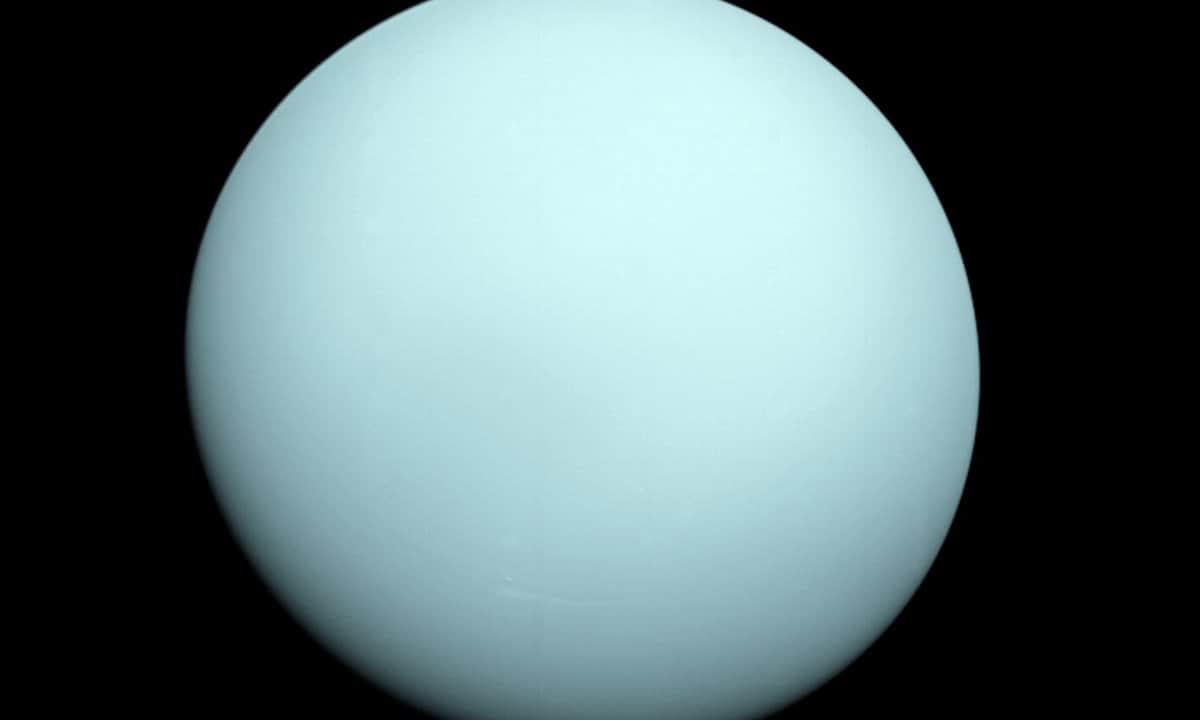Uranus, the seventh planet in our solar system, is the third gas giant, following Jupiter and Saturn, and it is also the third largest planet. In terms of mass, Uranus ranks fourth.
While Uranus is not the farthest planet from the Sun (Neptune holds that title), it is the coldest planet. This characteristic places Uranus, along with Neptune, in the category of ice giants. Unlike the other planets in our solar system, Uranus is unique and full of mysteries, capable of surprising us at any moment.
Discovery of Uranus: A Brief History
In the realm of modern astronomy, Uranus holds the distinction of being the first planet to be discovered using a telescope. While other planets, such as Mercury and Saturn, were easily visible to the naked eye and had been recognized since ancient times, Uranus remained hidden until William Herschel’s groundbreaking discovery on March 13, 1781. Utilizing a telescope that he had personally constructed, Herschel unveiled the existence of this celestial body, forever expanding our understanding of the universe.

William Herschel is renowned for his achievements in the field of astronomy, particularly his remarkable discovery of the planet Uranus.
Uranus, although appearing as a mere star with a magnitude of approximately 5-6, can actually be discerned by the naked eye under optimal conditions. Despite its frequent sightings, it was initially mistaken for an ordinary star. Due to its considerable distance from the Sun, Uranus’ orbital movement is barely perceptible and necessitates prolonged observations.
For instance, in 1690, the esteemed English astronomer John Flemsteed made meticulous observations of Uranus, even designating it as 34 Taurus. Other astronomers also documented their observations of this celestial body, yet none realized its planetary nature.
It was William Herschel who first observed that the appearance of this particular star was somewhat hazy and had a comet-like appearance. By utilizing magnification at 227x, then 460x, and finally 932x, Herschel discovered that this object was unlike typical stars in that it was magnified. Upon closer examination, Herschel noticed that the object was in motion, initially leading him to believe it was a comet.
Herschel then became perplexed by the fact that this supposed comet lacked a tail and had an almost perfectly circular orbit, as opposed to the strongly elongated elliptical orbits of comets. Other astronomers also found themselves puzzled by this object, as it resembled a planet more than a comet and was located too far from the Sun.
In 1783, William Herschel made the remarkable observation that the celestial body he came across was actually a planet within our solar system, a discovery that was previously unknown. This astonishing find earned Herschel a lifetime scholarship of 200 pounds sterling per year from King George III, a substantial amount during that era. It is worth noting that in 1787, Herschel also made the remarkable discovery of two moons orbiting Uranus – Titania and Oberon.
As the individual who made this groundbreaking discovery, William Herschel was granted the privilege of naming the planet he had encountered. Initially, he named it George’s Star as a tribute to the king. However, this name did not gain popularity, and astronomers ultimately decided to follow the tradition of naming planets after ancient Roman deities. Thus, the planet was named Uranus after the Greek god who is the father of Saturn, deviating slightly from the Roman tradition.
Distinctive Features of Uranus
Uranus stands out as a colossal gas giant, ranking third in terms of size, following Jupiter and Saturn. With a diameter 14.5 times that of Earth, it primarily consists of hydrogen, helium, and methane. Unlike terrestrial planets, Uranus lacks a solid surface and possesses an indeterminate boundary, much like other gas giants.
The unique attributes of Uranus are truly remarkable, as depicted in the following table.
Composition of Uranus
The structure of Uranus sets it apart from other gas giants. While further research is needed, scientists have developed a model based on existing data.
Uranus has a mass that is 14.5 times greater than Earth, but it is relatively light compared to other giant planets and ranks second in density after Saturn. Interestingly, even though Neptune is smaller in size, it actually weighs more than Uranus. This is because Uranus is primarily composed of ice, water, methane, and ammonia, with only a small amount of rock in its core. This is why Uranus is often referred to as an ice giant.
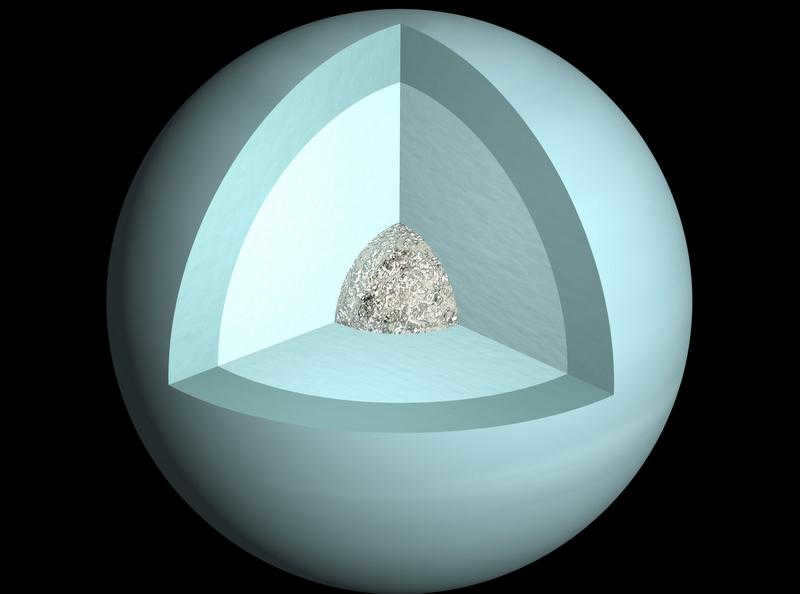
The composition of Uranus consists of a solid core, a mantle, and an atmosphere.
Located in the center is the core, which is composed of a combination of rock and ice. It occupies merely 20% of the planet’s radius.
Enveloping the core is the liquid mantle, which occupies approximately 60% of the planet’s radius. Although it is icy, it does not possess the characteristics that we typically associate with ice. The temperature within the mantle reaches a scorching 5,000 degrees and is subject to immense pressure. This unique amalgamation of water, methane, and ammonia exists in a state known as hot ice.
Finally, there is a layer of atmosphere that encompasses an additional 20% of the planet’s radius.
Uranus lacks a discernible surface. Its atmospheric gases seamlessly transition into a liquid state, making it impossible to precisely determine the boundary. Consequently, the point at which the pressure reaches 1 bar is considered the surface, with everything above that point classified as part of the atmosphere.
The Temperature of Uranus
Uranus, similar to Jupiter and Saturn in its gaseous composition, stands apart with its abundance of ice in its atmosphere. The temperature of Uranus’ atmosphere plummets to a bone-chilling -224°C, making it the coldest planet in our solar system. This extreme cold persists on both the illuminated and dark sides of the planet.
Comparatively, other gas giants in the solar system emit more heat than they receive from the Sun. Even Neptune, which shares similar characteristics with Uranus but is much farther away, emits 2.61 times more heat than it absorbs. This energy release is a result of gravitational compression and core rotation. However, Uranus releases heat from a square meter even less than Earth, almost negligible in comparison.
This phenomenon is quite peculiar and scientists have yet to uncover the reasons behind it. One hypothesis suggests that the heat emitted from the planet’s interior is unable to escape beyond its atmosphere due to some unknown factor that hinders its release. It is possible that this barrier could be a layer of atmosphere with a distinct composition. However, the heat must go somewhere, leading to another theory that deep within Uranus, there could exist a layer of liquid water, which in turn could harbor the potential for life.
Uranus, the coldest planet in our solar system, is not as straightforward as it may appear. When it is not radiating heat outward, it appears to be dissipating it internally. It is plausible that we may observe a phenomenon similar to the greenhouse effect seen on Venus. Of course, there are other possible explanations, but there is still insufficient data to draw definitive conclusions.
The Composition of Uranus’ Atmosphere
Uranus’ atmosphere is primarily composed of hydrogen, accounting for approximately 83% of its makeup, with helium making up around 15%. In addition to these gases, there are also significant amounts of methane and acetylene present. The presence of methane in particular is responsible for the planet’s distinctive green-blue hue, as it absorbs the red part of the spectrum. This unique combination of gases gives Uranus its fascinating coloration.
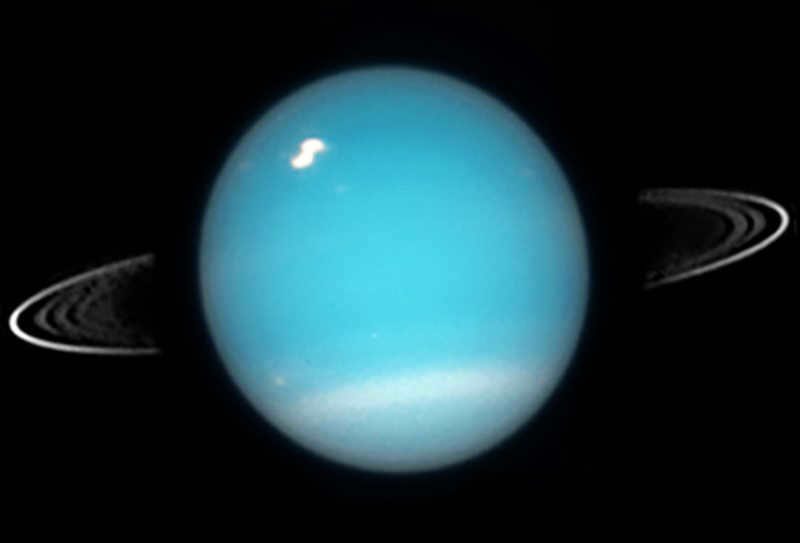
The presence of methane in the atmosphere gives Uranus its distinctive bluish color.
Unlike other planets, Uranus does not have a clearly defined boundary between its atmosphere and surface. This is because it lacks a solid surface altogether. As a result, it is difficult to determine the thickness of Uranus’ atmosphere without a reference point. If we were to descend into it from space, we would observe a gradual increase in pressure until the gas transitions into an intermediate semi-liquid state, and eventually into a liquid state. However, it is impossible to pinpoint at what altitude these transitions occur, as the change in gas state is gradual rather than abrupt.
In the lowest layer – known as the troposphere, water clouds dominate, resembling those we are accustomed to on Earth. Above them are clouds composed of ammonium hydrosulfide, followed by clouds of hydrogen sulfide and ammonia. Further up, methane clouds reside. The troposphere is a highly turbulent region with strong winds, abundant cloud cover, and shifting seasons.
Ascending higher, we encounter the tropopause and stratosphere, where a fog-like layer consisting of ethane and acetylene forms along the lower portion. Voyager 2 recently recorded the frigid temperature of -249 degrees Celsius in the tropopause. The combination of low temperatures and the fog layer contributes to Uranus’ lackluster appearance, devoid of intricate details. In reality, the depths remain concealed, and only a sparse number of clouds exist in the uppermost layers.
It is quite peculiar that the uppermost layers of the atmosphere, namely the thermosphere and corona, possess higher temperatures in comparison to the lower layers. This phenomenon presents yet another enigma surrounding Uranus, as the amount of energy provided by the Sun is insufficient to raise the temperature of these layers to 500 0 C.
Furthermore, another distinctive characteristic of Uranus is the expansion of the thermosphere up to a distance of 50,000 kilometers, which is equivalent to two times the planet’s radius.
Orbit
The planet Uranus is located at a distance of 19.19 astronomical units (a.u.) from the Sun, making it 19 times farther away than the Earth. This vast distance amounts to approximately 2.8 billion kilometers in terms of kilometers. What’s truly remarkable is that the orbit of Uranus is not a perfect circle, but rather slightly elongated. At its farthest point from the Sun, Uranus is situated a staggering 3 billion kilometers away.
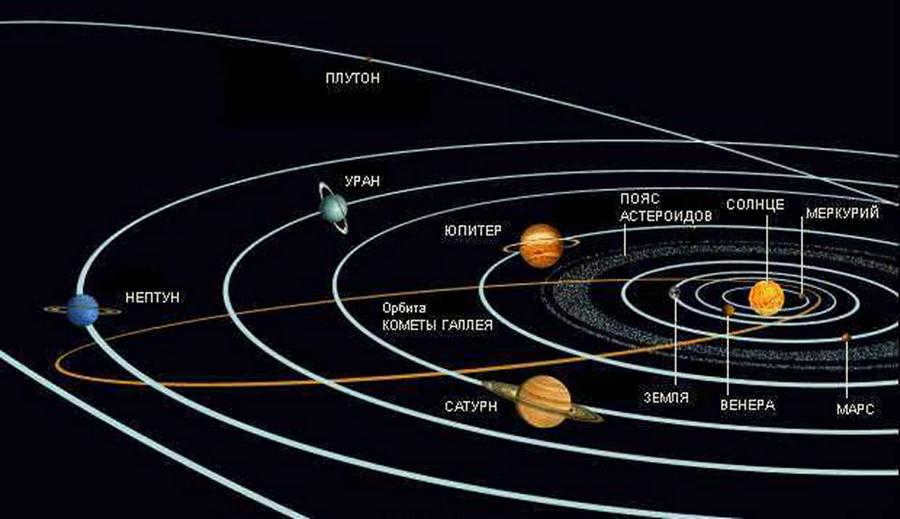

Uranus is the seventh planet in our solar system.
This celestial body takes 84 Earth years to complete one full orbit around the Sun, making its path exceptionally lengthy. To put it into perspective, since William Herschel discovered Uranus in 1781, the planet has just concluded its third revolution. This extended timeframe may seem substantial, surpassing two centuries, but in reality, Uranus has only been known to us for three years.
Due to its significant distance from the Sun, Uranus receives a mere 400 times less energy compared to what the Earth receives.
Uranus possesses a distinctive characteristic – its axis of rotation is inclined at an angle of 97.86 degrees, giving it the appearance of being tilted on its side. In addition, its orbital path is akin to that of a rolling object, in contrast to the other planets which rotate on a fixed axis. As a result, one hemisphere of Uranus remains illuminated for a period of 42 years, while the other hemisphere experiences darkness. Following this, the opposite hemisphere then enjoys a 42-year long day. During this time, the Sun stands directly overhead at the pole, while rising and setting rapidly at the equator. Naturally, these phenomena would be observable from the planet’s surface, provided it is not obscured by dense cloud or fog cover.
The Unique Rings of Uranus
While Saturn’s rings are undeniably stunning, many are unaware that other gas giants – Jupiter, Uranus, and Neptune – also possess their own magnificent adornments. Admittedly, the rings encircling Uranus may not be as awe-inspiring, but they are certainly real. These delicate rings can only be observed from prominent observatories on Earth, and even then, their visibility is inconsistent due to their thin composition and poor light reflection, in stark contrast to Saturn’s luminous rings. Comprised of minute, dusky particles ranging from micrometers to tens of centimeters in size, the rings of Uranus possess their own unique charm.
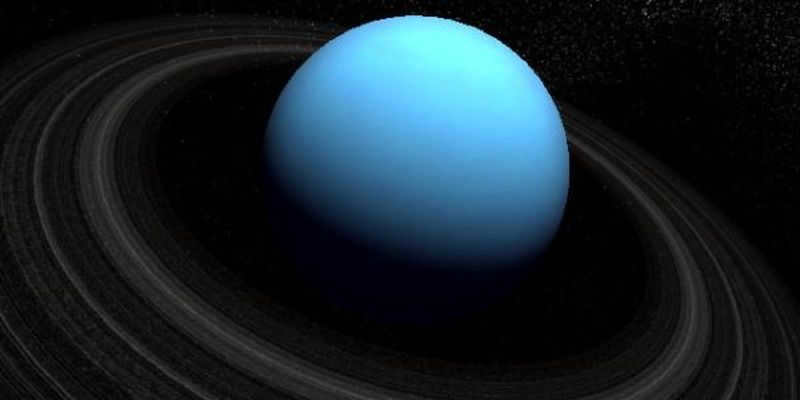

This is an approximation of the appearance of the rings surrounding Uranus.
Uranus is home to a total of 13 rings, with the brightest one known as the epsilon (ε) ring. These rings vary in color and brightness, and they all have wide gaps between them. Scientists theorize that these rings are relatively young and have formed recently. It is possible that they are remnants of a satellite that collided with another celestial body or were disrupted by the tidal forces exerted by the planet.
The discovery of Uranus’ rings was serendipitous, occurring in 1977 when a group of scientists observed the planet passing in front of a distant star. Analysis of the collected data revealed irregular fluctuations in the star’s brightness, occurring on either side of the planet. This unexpected finding led to the identification of nine rings.
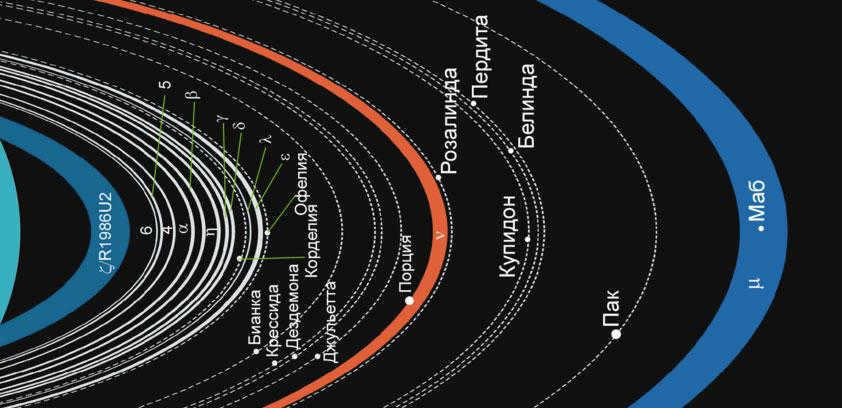

In 1989, Voyager 2 captured stunning images of the rings encircling Uranus, leading to the discovery of two additional rings. Further exploration using the Hubble telescope in 2005 revealed the existence of two more rings, bringing the total count to thirteen.
Interestingly, back in 1789, William Herschel observed a ring around Uranus and even described it as being red in color. However, subsequent astronomers failed to detect these rings, dismissing Herschel’s findings as an error. Strangely enough, the second-to-last ring is indeed red, lending credence to Herschel’s initial observations. The question remains: how did Herschel manage to see these rings? Did he simply assume their presence? This mystery continues to puzzle scientists to this day.
Uranus’ moons
Currently, scientists have identified 27 moons orbiting Uranus. The largest one is Titania, measuring 788 kilometers in radius. Interestingly, this makes it only half the size of our own Moon. Some other notable moons include Miranda, Ariel, Umbriel, and Oberon. However, when you consider all of Uranus’ moons combined, Triton, one of Neptune’s moons, still outweighs them.
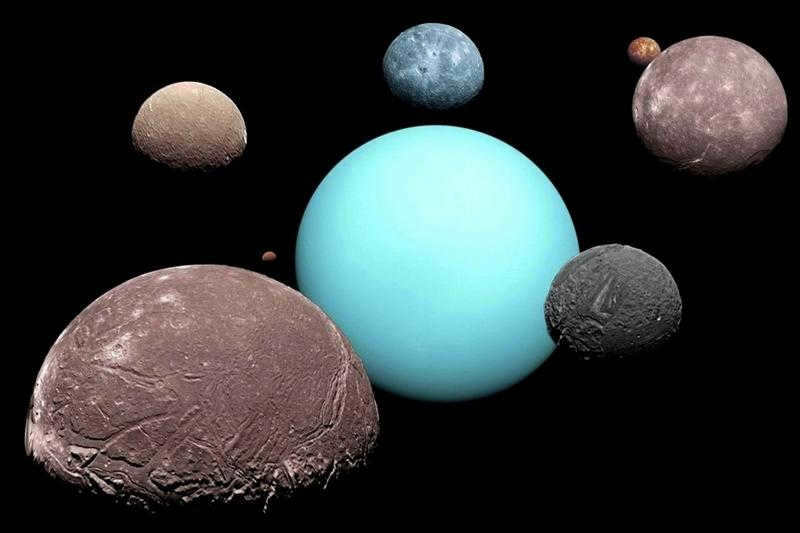

Here is the visual representation of the largest moons orbiting Uranus.
The moons orbiting Uranus consist of a combination of ice and rock, in approximately equal proportions. Their outer surface appears dark and has a low light reflection capability. Nevertheless, the moons Titania and Oberon were initially discovered by William Herschel back in 1787.
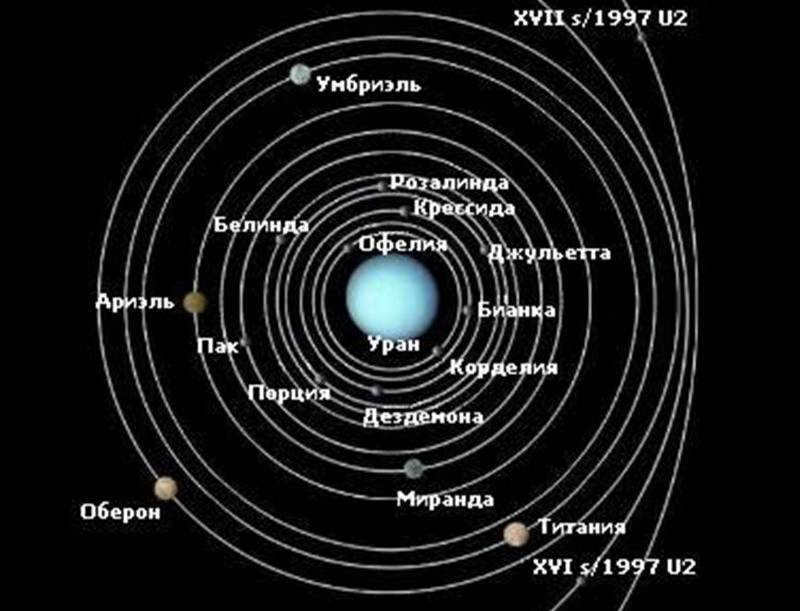
Amazing facts about Uranus
Summarizing a plethora of information, we can highlight the most fascinating facts about the enigmatic planet Uranus.
- Uranus was observed by numerous individuals, although they mistook it for an ordinary faint star. It was only in 1781 that William Herschel, using a homemade telescope, discovered that it is indeed a planet.
- The planet’s appellation was coined by the German astronomer Johann Bode. The reasoning was simple – Saturn is the father of Jupiter, hence the subsequent planet should be named after Saturn’s father – Uranus.
- Only one spacecraft has ventured close to Uranus – Voyager 2 in 1986. It approached the planet at a distance of 81.5 thousand kilometers and gathered a wealth of invaluable data.
- Wind speeds on Uranus can reach an astounding 240 meters per second. Additionally, the planet experiences powerful thunderstorms.
- Uranus has a distinctive greenish-blue color because its atmosphere contains methane, which absorbs the red part of the light spectrum.
- Among all the planets in the solar system, Uranus holds the title for being the coldest. Its temperature plunges to a bone-chilling -224 degrees, just a hair away from absolute zero.
- Unlike its fellow gas giants, Uranus emits very little heat of its own.
- There is a possibility that liquid water exists on Uranus, and it could potentially harbor some fascinating forms of life.
- Uranus is known for its unique characteristic of “rolling on its side” in its orbit, primarily due to its extreme axis tilt of nearly 98 degrees.
- In astrology, Uranus governs the constellation Aquarius.
- Deep within Uranus, under extreme temperature and pressure conditions, it is conceivable for a state of liquid ice to exist.
Exploring Uranus
Studying Uranus presents several challenges due to its great distance from Earth, making it a difficult target even for powerful terrestrial telescopes. Consequently, much of the available data on Uranus is obtained through the utilization of the Hubble Space Telescope.
The Voyager 2 spacecraft is the only probe to have successfully reached Uranus thus far. Launched in 1977, it flew past Uranus in 1986, capturing images of the planet, its rings, and its largest moons. During its journey, Voyager 2 also made significant contributions to atmospheric and magnetospheric research, and even discovered 10 new moons. The data transmitted by Voyager 2 proved to be invaluable. However, no subsequent missions have been sent to explore Uranus.
Future missions to explore the outer planets, including Uranus, have been planned for the coming decade. Whether these missions will come to fruition remains uncertain.
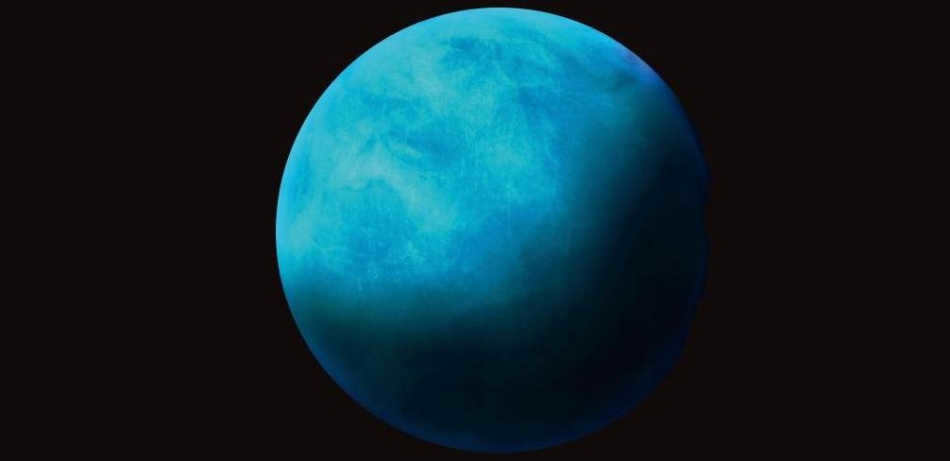
Uranus, the seventh planet in our Solar System, was first observed through a telescope and is the smallest of the giant planets. It is situated approximately 3 billion kilometers away from Earth and 2.87 billion kilometers away from the Sun.
Discovery Timeline
Credit for the discovery of Uranus in 1781 goes to William Herschel, a German-born English astronomer. Herschel used his homemade reflector telescope to observe celestial bodies, initially mistaking Uranus for a star or comet. It was only two years later that Uranus was officially classified as a planet, thanks in large part to the observations made by astronomer Johann Ehlert Bode.
Herschel had a desire to bestow the name Georgium Sidus on the planet he had come across, as a tribute to King George III. However, the Society of Astronomers did not approve of this suggestion. Instead, they opted to name it Uranus, after the god of the sky. This alternative name was proposed by Bode and received greater approval from the members of the astronomical society. In addition to the planet, Herschel also discovered two satellites orbiting it – Titania and Oberon.
The weight of Uranus is 8.69*1025 kg. It is 14 times bigger than the Earth. Uranus has a diameter that is 4 times that of Earth. Its equatorial diameter measures 51118 km, while its polar diameter measures 49946 km. The planet’s axis is tilted at an angle of 98 degrees. Uranus takes 17 hours and 15 minutes to complete one revolution. It takes 84.5 years for Uranus to orbit around the Sun. The planet’s orbital velocity is 6.8 km/s. Uranus has a density of 1.27 g/cm³.
Description of the celestial body
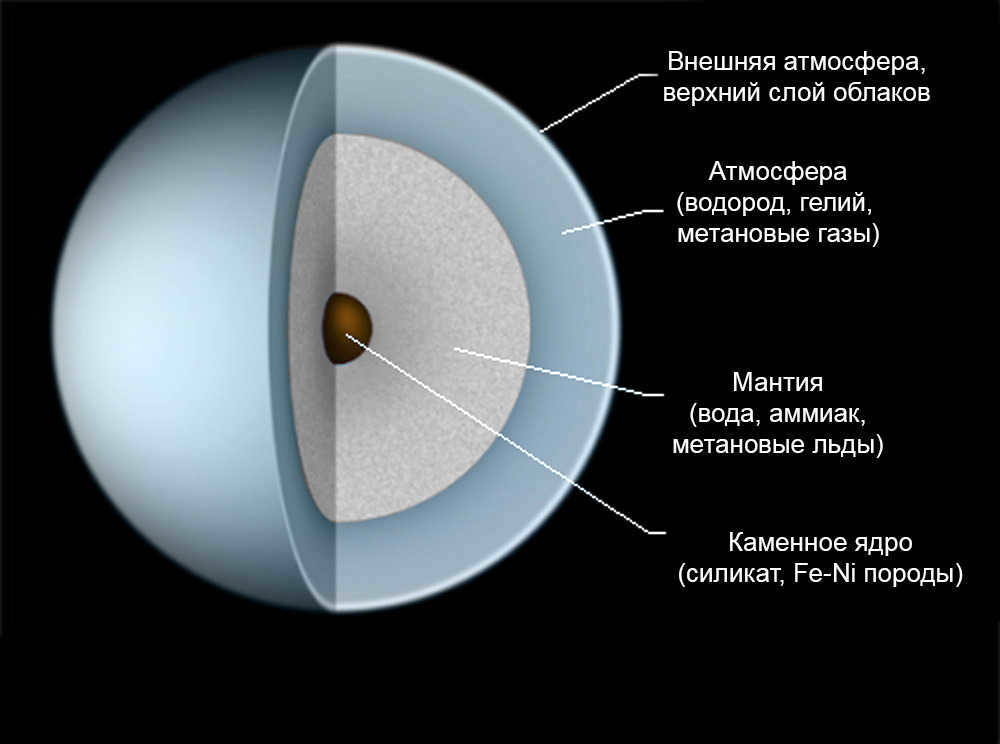
Uranus came into existence shortly following the Sun’s inception, approximately 4.6 billion years ago. It is commonly classified as an ice giant, consisting predominantly of water, methane, and ammonia. The composition of its atmosphere primarily consists of molecular hydrogen and atomic helium, with a minor presence of methane. This celestial body possesses the lowest temperature amongst all the planetary atmospheres within the solar system, measuring at 49 K.
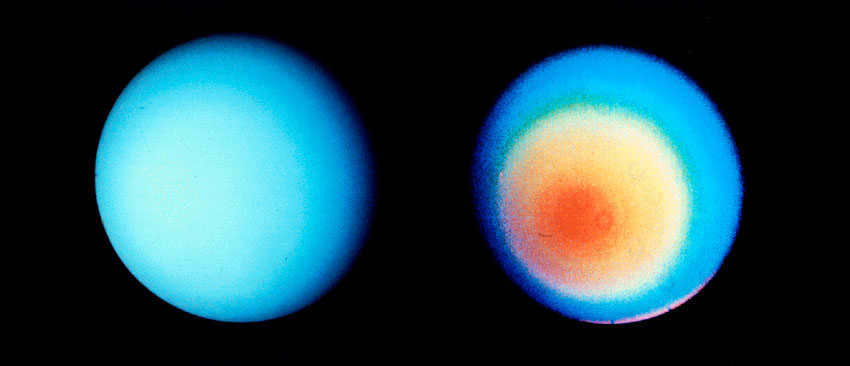
The northern pole of the planet is located above the ecliptic. Uranus rotates in a retrograde manner around it. The axis of the planet’s magnetic field is significantly tilted and offset from the center of the planet. When NASA’s Voyager 2 space probe was launched in August 1970 and passed by Uranus in 1982, the north pole of the planet was in darkness.
Scientists hypothesize that the planet may contain liquid water and potentially support life, although not in the same way as on Earth. The temperature, pressure, and composition of the planet are too extreme and volatile for life as we know it on Earth. As an ice giant, Uranus lacks a solid surface.
Fascinating information about the Earth
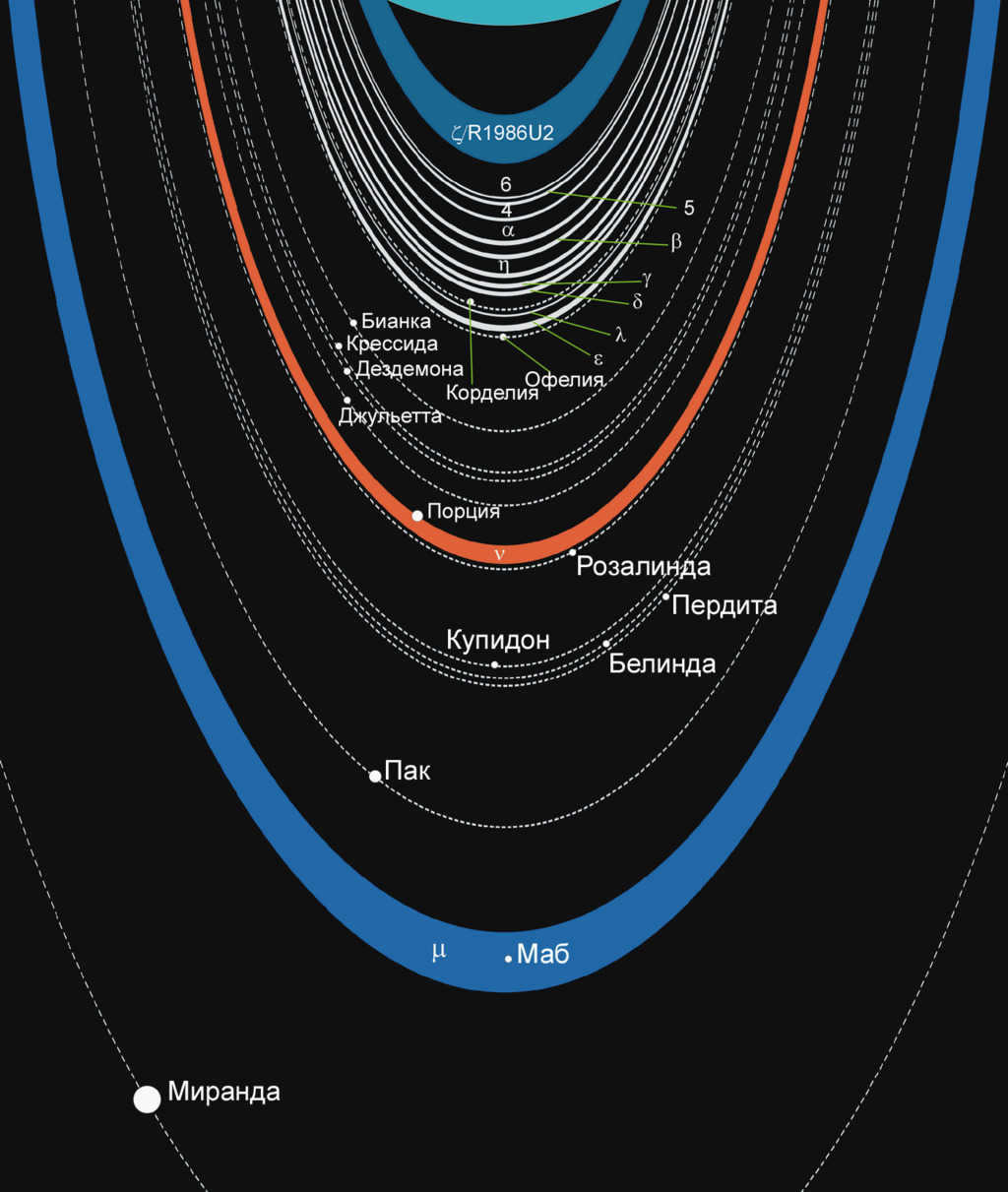

- Astronomers have given the names of characters from the works of William Shakespeare and Alexander Pope to twenty-seven satellites of Uranus. Some of them orbit outside the planet’s rings.
- There are 13 rings known to exist around the planet. The inner ones have a dark color, while the outer ones are bright.
- It is believed that the average surface temperature of the planet is +47°C in the troposphere and +5000°C in the ammonia seas.
- Unlike other planets in the solar system, Uranus derives its name from Greek mythology rather than Roman mythology.
Queries and responses
Titania is the biggest moon of Uranus.
Uranus, the seventh planet from the Sun and the third largest planet in the Solar System after Jupiter and Saturn, boasts a variety of moons and a ring system.
While it can be observed without the aid of telescopes, its planetary classification was not established until the 18th century. Let’s delve into fascinating details about Uranus for both kids and grown-ups.
Engaging Details
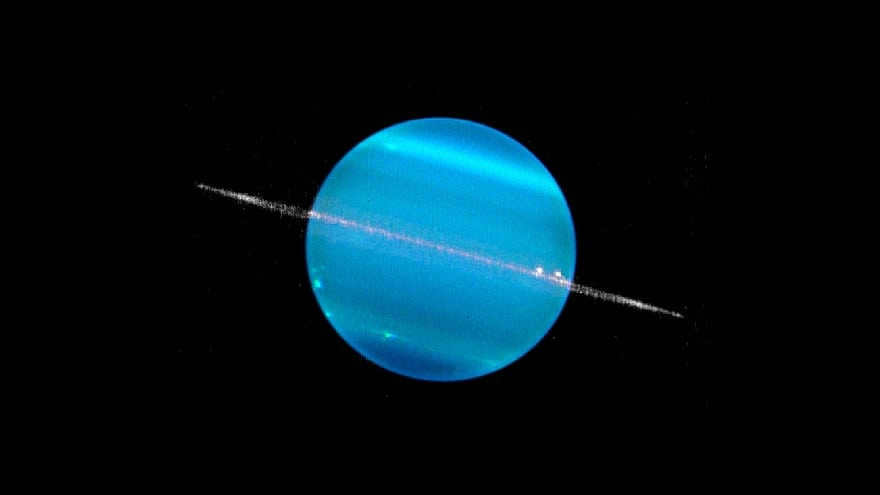

- Due to its dimness, ancient humans were unable to see Uranus. Initially, Herschel mistakenly identified it as a comet, but it was eventually recognized as a planet after a few years. While Herschel wanted to name it “George’s Star,” Johannes Bode’s suggestion was deemed more suitable.
- Certain regions of Uranus have a direct view of the Sun, resulting in periods of approximately 42 years of continuous sunlight. The remaining time is characterized by darkness.
- Similar to other gas giants, Uranus has a hydrogen and helium upper layer. Below that lies an icy mantle surrounding an icy and rocky core. The upper atmosphere consists of water, ammonia, and methane ice crystals.
- Being the coldest planet, Neptune has a temperature reading of -224°C. Occasionally, it even cools down further, but most of the time it is Uranus that experiences freezing temperatures. Moreover, the upper atmospheric layer of Neptune is covered by a methane haze that conceals storms.
- The particles on Neptune are extremely tiny. It possesses a total of 11 inner rings and two outer rings. These rings were formed as a result of ancient satellites colliding. Interestingly, the first rings were not discovered until 1977, and the remaining rings were observed in images captured by the Hubble telescope between 2003 and 2005.
- Interestingly, all of Uranus’ satellites are named after characters from the works of William Shakespeare and Alexander Pope. Among them, Miranda is particularly intriguing due to its icy canyons and peculiar surface appearance.
Size, mass and orbit
Uranus, a gas giant, has a radius of 25360 km, a volume of 6.833 × 10 13 km 3, and a mass of 8.68 × 10 25 kg. This makes it 4 times larger than Earth and 63 times its volume. However, its density of 1.27 g/cm 3 is lower than ours.
Uranus possesses the most variable distance from the Sun, with a range of 2,735,118,110 km to 3,006,224,700 km. Its average distance is approximately 3 billion km, and it takes 84 Earth years to complete one orbit.
The axial rotation of Uranus lasts for 17 hours and 14 minutes, which constitutes a day on this planet. An evident wind in the direction of rotation is observed in the upper atmospheric layer. In certain latitudes, objects move at a heightened speed and complete a full revolution in just 14 hours.
Orbit and rotation of Uranus
| 3,004,419,704 km 20,083,305 26 a. e. |
| 2,876,679,082 km 19.229 411 95 a. e. |
One fascinating aspect of Uranus is its unique rotational pattern. Unlike other planets with only a slight axial tilt, Uranus has an eccentricity of 98°. This results in dramatic changes for the planet. While the equator experiences normal day and night cycles, the poles have incredibly long spans of 42 years each!
Composition and Surface
The structure of Uranus consists of three layers: a solid core made of rock, a mantle composed of ice, and an outer shell consisting of hydrogen (83%) and helium (15%) in a gaseous state. The presence of methane ice, which makes up 2.3% of the composition, gives Uranus its distinctive blue color. The stratosphere of Uranus contains various hydrocarbons, such as ethane, diacetylene, acetylene, and methylacetylene. The photograph below provides a closer look at the internal structure of Uranus.
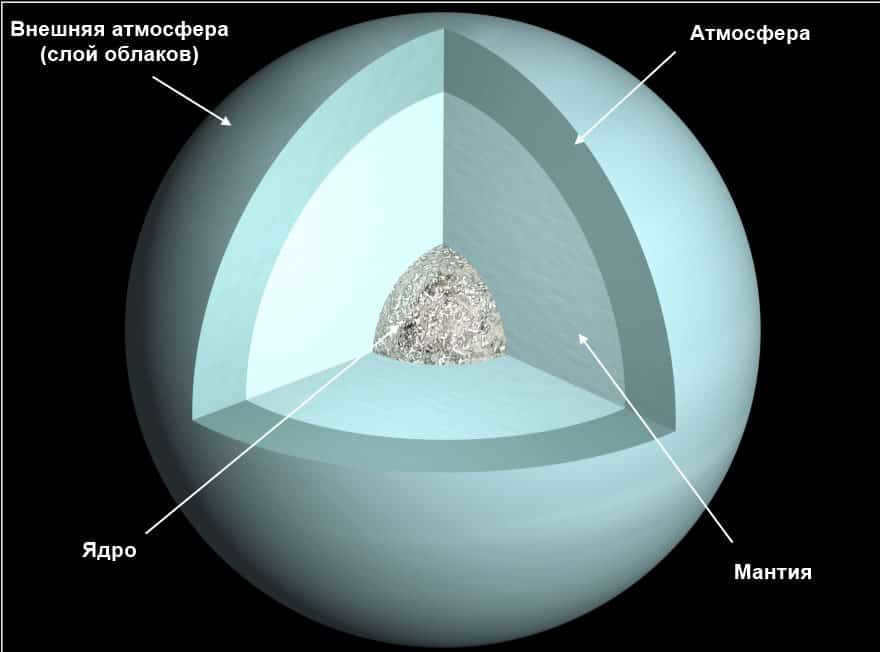
The composition of Uranus’s inner layers has been determined through spectroscopy. Scientists have detected the presence of carbon monoxide, carbon dioxide, and icy clouds containing water vapor, ammonia, and hydrogen sulfide. As a result of these findings, Uranus, along with Neptune, is classified as an ice giant.
The ice mantle of Uranus consists of a dense, hot liquid containing water, ammonia, and other volatile substances. This liquid, known as the water-ammonia ocean, exhibits high electrical conductivity.
Compared to Earth, Uranus’s core is relatively small, making up only 0.55 times the mass of our planet. The mantle, on the other hand, accounts for 13.4 times the mass of Earth, while the upper atmospheric layer contributes 0.5 times the mass of our planet.
Satellites
The group is made up of the 27 currently identified satellites of Uranus, categorized as major, inner, and irregular satellites. The biggest ones are known as Miranda, Ariel, Umbriel, Oberon, and Titania. These satellites have a diameter larger than 472 km and a mass of 6.7 x 10^19 kg for Miranda, and 1578 km and 3.5 x 10^21 kg for Titania.
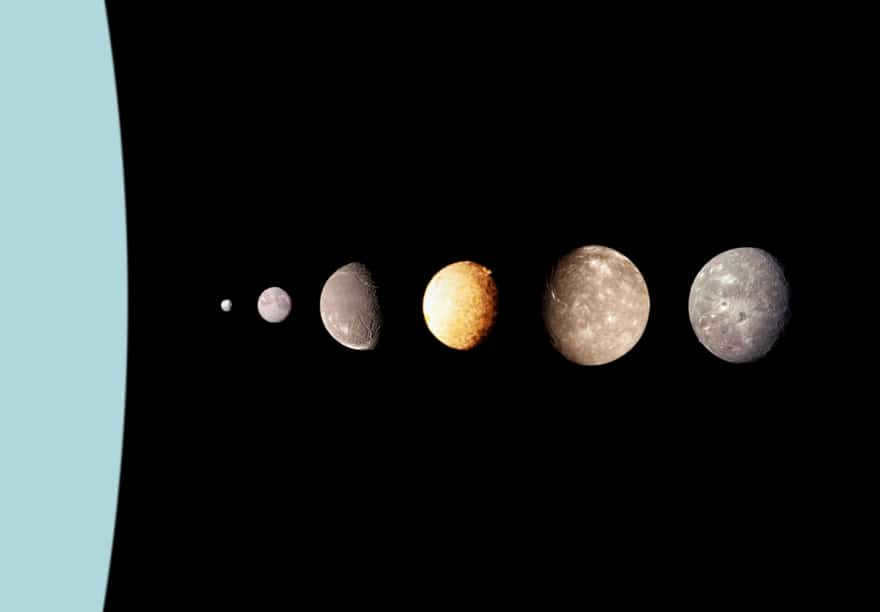
When comparing Uranus’ largest satellites to the planet itself, it is evident that they all originated from a long-standing accretion disk during the planet’s formation. Each moon consists of a balanced combination of rock and ice, except for Miranda, which is primarily composed of ice.
We can also observe the presence of ammonia, carbon dioxide, and the rocky material on the surface is composed of carbonaceous material and organic compounds. It is believed that there may be a liquid water ocean located between the core and mantle of Titania and Oberon. The surface is adorned with numerous craters. Ariel is considered the youngest and most pristine of the satellites, while Umbriel bears the scars of its ancient age.
The main moons do not possess an atmosphere, and their orbital paths result in significant seasonal variations. There are 13 inner moons: Cordelia, Ophelia, Bianca, Cressida, Desdemona, Juliet, Portia, Rosalind, Cupid, Belinda, Perdita, Puck, and Mab. Each of these moons has been named in honor of characters from Shakespeare’s works. The photograph showcases the satellites and rings of Uranus.
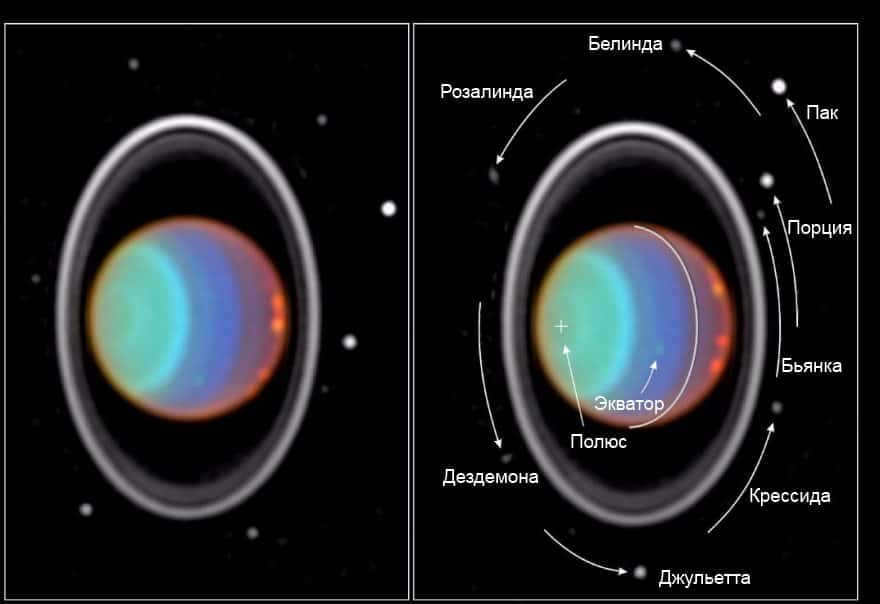

The inner moons have a strong connection to the ring system surrounding the planet. Puck, with a diameter of 162 kilometers, is the largest moon in this group and the only one that Voyager 2 was able to image.
All of these moons appear dark in color, composed of water ice mixed with dark organic material. The system is unstable and models suggest that collisions could occur, with Desdemona and Cressida being of particular concern.
There are 9 irregular moons that orbit farther out than Oberon. These moons were captured after the planet itself formed: Francisco, Caliban, Stefano, Trinculo, Sycorax, Margarita, Prospero, Setebos, and Ferdinand. They range in size from 18 to 150 kilometers. All of these moons orbit in a retrograde motion, except for Margarita.
The atmosphere of Uranus is divided into layers based on temperature and pressure. Being a gas giant, it lacks a solid surface. Remote probes have the capability to descend up to a depth of 300 km.
We can identify the troposphere, which extends 300 km below the surface and 50 km above it, with a pressure range of 100-0.1 bar. Additionally, there is the stratosphere, which spans from 50-4000 km and has a pressure range of 0.1-10 10 bar.
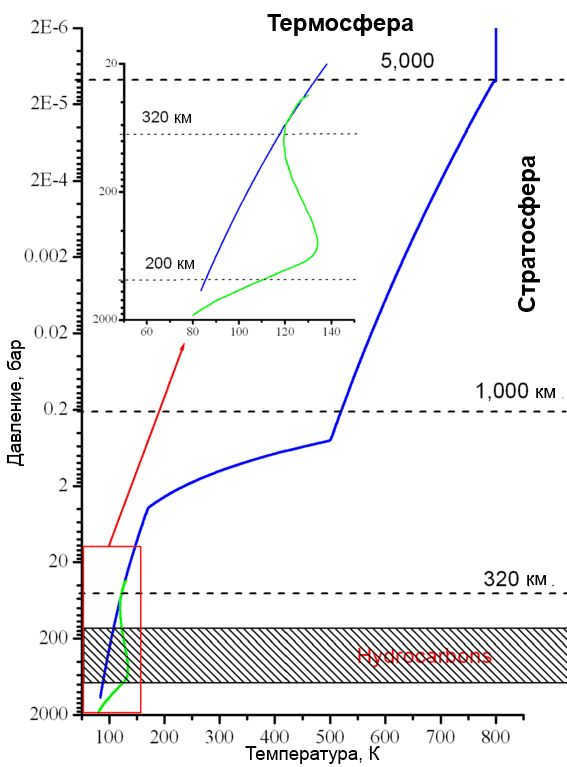

The temperature of Uranus varies depending on the height of the atmosphere and the pressure. The densest layer is called the troposphere, where the temperature can reach 46.85°C and drop to -220°C. The upper region of Uranus is known for being extremely cold. Most of the infrared rays are produced in the tropopause.
This is also the location of the clouds on Uranus. Below the tropopause, there are water clouds, ammonia clouds, and hydrogen sulfide clouds. Above the tropopause, there are thin methane clouds. In the stratosphere, temperatures range from -220°C to 557°C, and they are influenced by solar radiation. The appearance of the planet is created by ethane smog, which is present in this layer. Acetylene and methane contribute to the warming of this layer.
The thermosphere and corona extend from a point 4000-50000 km above the “surface” where the temperature remains at 577°C. The method by which the planet manages to heat up to such a degree is still unknown, as it is far from the Sun and lacks sufficient internal heat.
In terms of weather, it bears resemblance to the older gas giants. Bands encircle the planet, causing the winds to reach speeds of 900 km/h and giving rise to massive storms. In 2012, the Hubble telescope observed the presence of the Dark Spot, a massive vortex spanning 1,700 km x 3,000 km.
Rings
The rings of Uranus are composed of small, dark particles ranging in size from micrometers to fractions of meters, making them difficult to observe. Currently, there are 13 identified rings, with the brightest being epsilon, while two of them are narrow and stretch several kilometers wide.


This stunning photograph displays the vibrant rings encircling Uranus, taken by the Voyager spacecraft on January 21, 1986, when it was 4.17 million km (2.59 million miles) away from the planet. This image beautifully showcases all 9 of Uranus’ rings.
These rings are relatively young and formed after the planet itself. Scientists believe that they are remnants of a destroyed moon or perhaps multiple moons. In fact, the rings were first observed by James Elliott, Jessica Mink, and Edward Dunham in 1977, during the eclipse of the star HD 128598. They documented the presence of 5 distinct ring formations.
Study Background
Uranus is one of the five planets that were visible to the naked eye. However, due to its dim appearance and slow orbital path, ancient observers mistakenly identified it as a regular star. The earliest recorded mention of Uranus as a celestial object comes from Hipparchus in 128 BC, who classified it as a star.
The first accurate observation of Uranus was made by John Flamsteed in 1690. He observed it on multiple occasions and recorded it as a star named 34 Taurus. Pierre Lemonnier also made numerous observations of Uranus between 1750 and 1769, totaling about 20 sightings.

William Herschel used the aforementioned telescope to observe the planet Uranus.
However, it was not until 1781 that Herschel began observing Uranus as a planet. At first, he mistakenly believed it to be a comet due to its appearance resembling that of a planetary object. Eventually, other astronomers, such as Anders Lexell, joined the study and determined that Uranus had an almost circular orbit. This discovery was further confirmed by Johann Bode.
In 1783, Uranus was officially recognized as a planet, and Herschel was rewarded with a sum of 200 pounds from the king. In honor of his new patron, Herschel gave the object the nickname “George’s Star,” although this name did not extend beyond the United Kingdom.
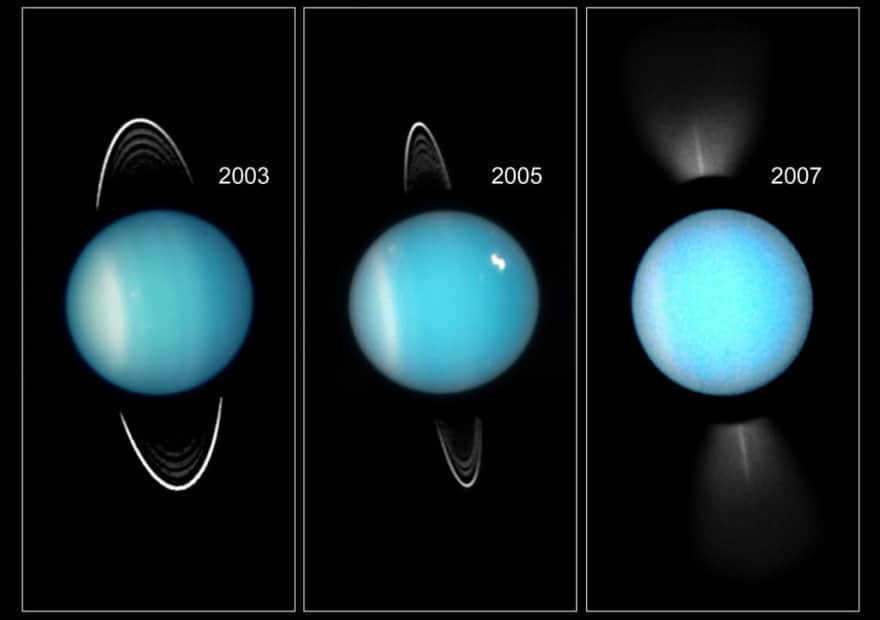
Uranus as observed through the lens of the Hubble Space Telescope.
Johann Bode proposed the contemporary name, which is derived from the Latin translation of the Greek god of the heavens. The name gained popularity and was formally adopted in 1850. Here is a depiction of Uranus on a map.
Map of the Surface


To view a larger version of the image, simply click on it
An exploration of the positioning and movement of Uranus
In Ukraine, the Trinity holiday is known as Green Sunday. In anticipation of this occasion, we have put together an article discussing Uranus, the greenest planet in our solar system. What is responsible for its unique coloration?
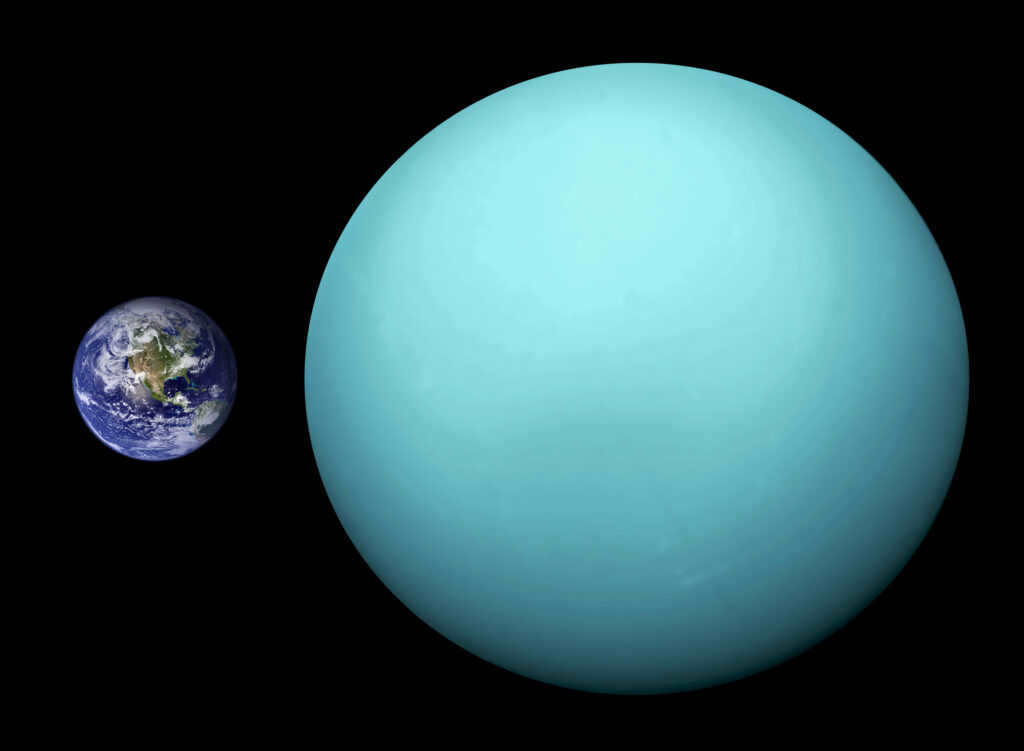
Green color: Earth vs Space
The Trinity, a Christian holiday, goes by different names. For believers, it is known as the Day of the Descent of the Holy Spirit. Another name for it is Pentecost, as it is observed 50 days after Easter. However, in Ukraine, it is primarily recognized as the Green Holidays.
This title combines Christian beliefs with ancient pagan traditions, particularly the rituals of adorning houses with plant branches. On Earth, the color green is closely associated with vegetation. This vibrant hue symbolizes a planet teeming with life, even when viewed from space.
Interestingly, green is a rare color in the Universe. The radiation emitted by heated objects spans from red to orange, yellow, white, and finally blue. This explains the absence of green stars.
If we did not have Uranus in our solar system, the color green could be seen as a reliable indicator of life. However, on Uranus, green is even more prevalent than on Earth, yet there are no trees on the planet.
Uranus and Neptune
Uranus and Neptune display a wide range of colors, ranging from deep blue to pale green, depending on the lighting and observing conditions. This variation is due to the composition of their atmospheres.
The atmospheres of these planets are primarily made up of hydrocarbons, with methane being the main component. Methane absorbs wavelengths from red to yellow, while reflecting the rest. This combination of reflected green, blue, and blue wavelengths is what gives the planets their distinct colors.
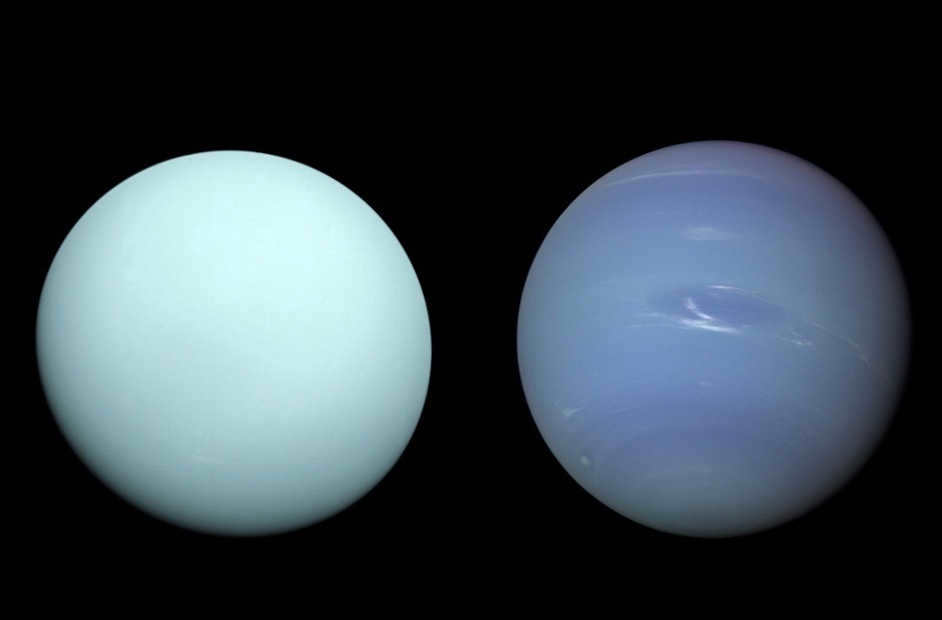
Underneath the outer atmosphere of the ice giants, there are layers consisting of methane, ammonia, and water ice. These substances scatter light, giving both planets a bright blue color. However, the ice crystals in Uranus’ atmosphere also contain a higher concentration of heavy hydrocarbon methane, particularly ethane and acetylene. These crystals are gray in color and contribute to the green appearance of Uranus.
Why is Uranus green while Neptune is not?
The main distinction between these two ice giants lies in their outer layers. Uranus has a greater abundance of methane compared to Neptune. This higher concentration of methane leads to the formation of gray ice crystals in Uranus’ atmosphere, which gives the planet its distinct green hue. On the other hand, Neptune has a lower concentration of methane, resulting in a different coloration.
A mist is created that allows for the passage of various wavelengths with varying degrees of effectiveness. The deepest blue hue is most effectively concealed by this mist. Due to the tranquil atmosphere of Uranus, which is the calmest among the gas giants, this veil remains intact and blankets the entire planet in a relatively uniform manner, without breaking up into distinct cloud bands.
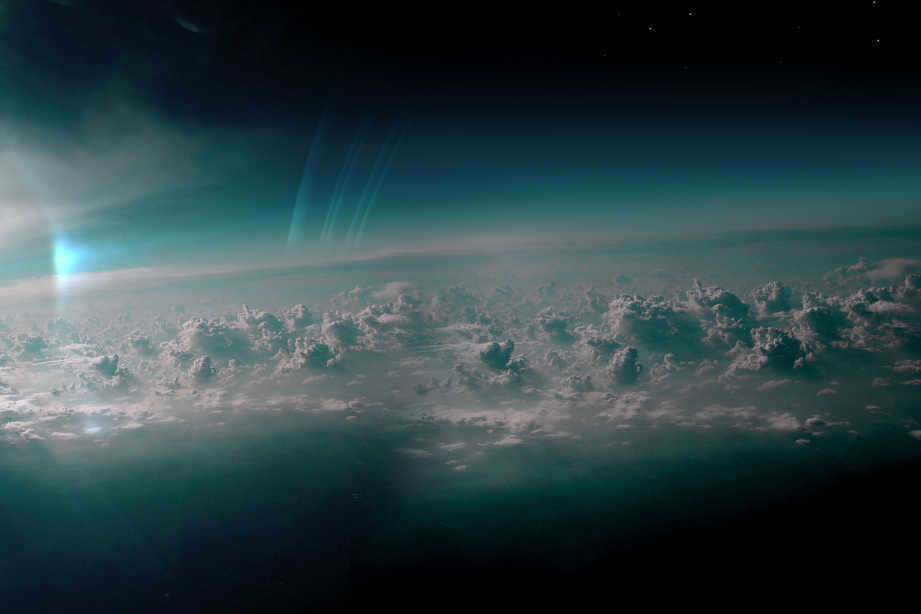
Neptune also possesses a similar layer of mist. However, it is significantly thinner and cannot obstruct our view of the planet’s mesmerizing depths or the contrasting cloud bands beneath it. The lack of vegetation as the source of Uranus’ green hue is evident in its color, which is not as vibrant as the lush forests on Earth, but rather closer to a blue shade.
Stay updated with the most intriguing news and facts through our Telegram channel!
Join us: https://t.me/ustmagazine

I have been working as a news editor and feature writer, where my primary focus has been on popularizing science in Ukrainian for the past decade. With a PhD in engineering and experience teaching civil engineers, I have now shifted my attention towards educating the general public on various scientific topics. However, my passion for space has remained constant throughout the years. In my work, I strive to show appreciation for the scientists behind groundbreaking discoveries and the engineers responsible for space technology.
When it comes to our home solar system, there are countless fascinating facts about the planets. One such discovery pertains to Uranus, which astronomers have deemed the most peculiar planet based on numerous findings and extensive research.
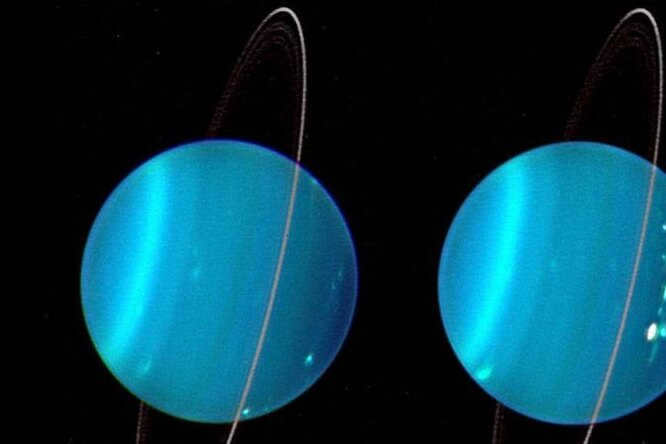
Would you believe that just three decades ago, the majority of scientists considered the solar system to be rather dull (except for Jupiter and Saturn, perhaps)? Our planet Earth seemed to revolve around the Sun alongside unremarkable clusters of rocks, with very little of interest. It’s even more astonishing to learn about the latest revelations regarding the quirks of Uranus. Below, we present the most fascinating details about this enigmatic planet.
The solar system came into existence over four and a half billion years ago. Thanks to information gathered from various space probes, researchers are continuously uncovering new revelations. What makes scientists label Uranus as the most peculiar planet?
Unfathomable, yet undeniable!
Uranus is an absolutely astounding celestial body. Its uniqueness lies in the fact that the equatorial plane of Uranus is inclined at an angle of 98° to the plane of its orbit, causing the planet to rotate in a retrograde manner, as if it were reclining on its side. This peculiar characteristic has profound implications. While the other planets in our solar system resemble spinning tops, Uranus resembles a rolling sphere. This phenomenon profoundly impacts the planet’s cycle of day and night, as well as its magnetic field.
A recent research conducted by the Georgia Institute of Technology reveals that Uranus experiences a unique phenomenon where its magnetic field undergoes daily pole shifts. This means that the magnetic poles of Uranus change position every day. In contrast, Earth’s magnetosphere is fixed around the North and South poles. The consequences of a sudden pole reversal on Earth could be catastrophic. However, on Uranus, this occurrence happens on a regular basis. The planet’s magnetosphere is characterized by chaos, as it is tilted at an angle of 60 degrees to the planet’s rotational axis. Consequently, at times, the magnetosphere is “open,” while at other times, it is “closed.”
The enigmatic planet: unraveling the secrets of Uranus
Uranus, the enigmatic and peculiar celestial body, holds a special place in our solar system. Its uniqueness stems from its bone-chilling temperature of -224 degrees Celsius, making it the coldest planetary atmosphere in our cosmic neighborhood. This intriguing characteristic sets Uranus apart from its planetary counterparts, as it emits minimal heat and lacks the scorching cores found in other celestial giants. Moreover, the planet’s wind currents are nothing short of astonishing. Astronomers have uncovered that these gusts can reach mind-boggling speeds of up to 900 kilometers per hour.
Uranus got its name from the Greek deity who ruled over the heavens and was officially discovered by the renowned astronomer, William Herschel, in 1781. Throughout history, scientists have consistently classified Uranus as the most peculiar planet.
Tempests on Uranus
One of the distinctive characteristics of Uranus is its exceptional climate. As per the information provided by NASA, when sunlight reaches specific regions after an extended period, it warms up the atmosphere, resulting in the formation of colossal spring storms. However, during a heatwave in the southern part of Uranus in 1986, the Voyager 2 space probe captured photographs revealing a sphere with approximately ten observable clouds. Strangely enough, this observation is what led to Uranus being labeled as not just the most peculiar but also the “dullest planet”. Nonetheless, with the passage of time, Voyager 2 was replaced by the Hubble telescope, and the seasons on Uranus also underwent changes before astronomers managed to capture the planet’s extreme weather conditions.
The summer storms on Uranus were first documented in 2014. It is important to mention that these storms occurred seven years after Uranus made its closest approach to the Sun. This peculiar characteristic of Uranus has remained a puzzle for scientists. Alongside the storms, there are showers of diamonds that sink thousands of miles beneath the surface of these icy behemoths, Uranus and Neptune. Researchers explain that the extreme temperature and pressure in the atmospheres of these planets cause carbon and hydrogen to compress, resulting in the formation of diamonds. These diamonds then descend and accumulate around the cores of Uranus and Neptune. These captivating details have prompted NASA to contemplate potential missions to explore this enigmatic and extraordinary planet. With any luck, a mission to Uranus will be launched by 2034, shedding light on many unanswered questions. Without a doubt, Uranus stands as the most unconventional planet in our solar system. There is still an abundance of research to be conducted, which will contribute to a deeper understanding of the many mysteries surrounding this colossal ice giant.

